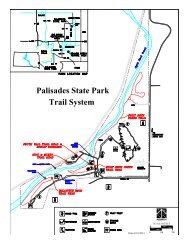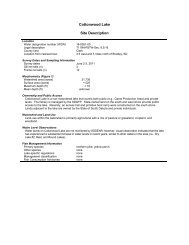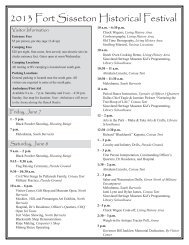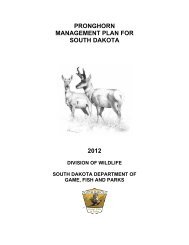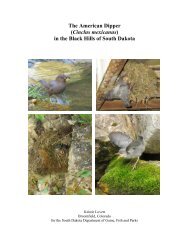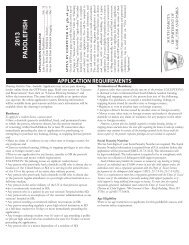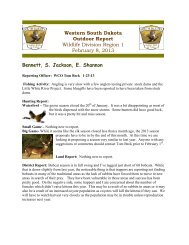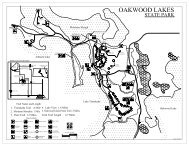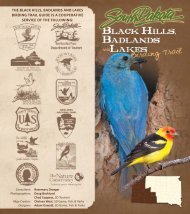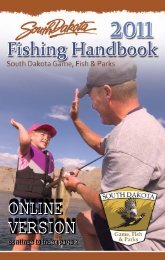pdf version - South Dakota Department of Game, Fish and Parks
pdf version - South Dakota Department of Game, Fish and Parks
pdf version - South Dakota Department of Game, Fish and Parks
You also want an ePaper? Increase the reach of your titles
YUMPU automatically turns print PDFs into web optimized ePapers that Google loves.
GLOSSARY OF TERMS<br />
Algae: a large <strong>and</strong> diverse group <strong>of</strong> organisms that, like plants, normally<br />
derive their energy from photosynthesis. The group includes diverse<br />
single-celled, colonial, <strong>and</strong> multi-celled forms. Algal blooms<br />
sometimes occur in unshaded water bodies, especially during summer,<br />
causing water to appear green.<br />
Barbel: whisker-like projection found around the mouth <strong>of</strong> many fi shes,<br />
sometimes also on the chin or snout (refer to image on page 4).<br />
Branchiostegal ray: bony ray supporting (embedded within) the gill<br />
membranes in the throat region, behind the lower jaw.<br />
Crustacean: member <strong>of</strong> a large <strong>and</strong> diverse group <strong>of</strong> invertebrate,<br />
arthropod organisms that are important prey for fi shes. Examples<br />
present in <strong>South</strong> <strong>Dakota</strong> are water fl eas (Daphnia), scuds (amphipods),<br />
<strong>and</strong> crayfi sh.<br />
Deciduous: dropping <strong>of</strong> a part that is no longer needed. In fi shes, deciduous<br />
scales are easily, accidentally lost from a fi sh during h<strong>and</strong>ling.<br />
Detritus: non-living organic (not rock) material, including remains <strong>of</strong><br />
plants, animals, <strong>and</strong> their waste products. Decaying detritus is an<br />
important source <strong>of</strong> energy in aquatic habitats.<br />
Escarpment: a steep slope that results from erosion or faulting <strong>and</strong><br />
separates two relatively level areas <strong>of</strong> differing elevations.<br />
Impoundment: water body created by blocking fl owing water, usually<br />
by a dam.<br />
Insect: member <strong>of</strong> a large <strong>and</strong> diverse group <strong>of</strong> invertebrate, arthropod<br />
organisms that are important prey for fi shes. Examples present in<br />
<strong>South</strong> <strong>Dakota</strong> are larvae <strong>of</strong> mosquitoes, fl ies, <strong>and</strong> dragonfl ies.<br />
Invertebrate: type <strong>of</strong> animal lacking a backbone.<br />
Keel: a distinct ridge, usually on the belly <strong>of</strong> a deep-bodied fi sh.<br />
Larva: early life stage <strong>of</strong> an animal that is distinct from juveniles <strong>and</strong> adults<br />
because larvae undergo metamorphosis, during which their appearance may<br />
change dramatically, in the transition to becoming a juvenile (resembles<br />
adult, but sexually immature) <strong>and</strong> adult (sexually mature) animal.<br />
Lateral line: sense organ used to detect movement <strong>and</strong> vibration in water.<br />
Lateral lines are usually visible as a faint line (marked by a series<br />
<strong>of</strong> motion receptors called neuromasts) that extends along each side,<br />
from the vicinity <strong>of</strong> the gill covers to the base <strong>of</strong> the tail (caudal) fi n<br />
(refer to image on page 4).<br />
Mollusk: member <strong>of</strong> a large <strong>and</strong> diverse group <strong>of</strong> invertebrate organisms<br />
that are prey for fi shes adapted to crush their hard shells. Examples<br />
present in <strong>South</strong> <strong>Dakota</strong> are snails <strong>and</strong> clams.<br />
Nocturnal: activity is largely restricted to nighttime.<br />
Omnivore: animal that eats both plant <strong>and</strong> animal material.<br />
10




